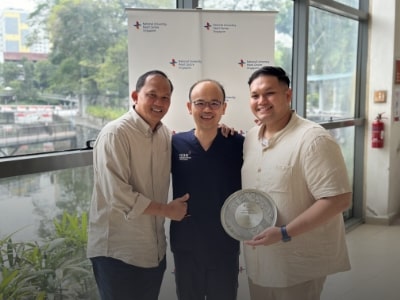Published on 6 November 2025
About 1 per cent of people live with a rare lung condition that leaves them breathless. One survivor is showing that with support and awareness, life can go on.
At a glance
- Pulmonary hypertension (PH) is a rare heart and lung condition affecting about 1 in 100 people worldwide.
- A more severe form, pulmonary arterial hypertension (PAH), occurs in about 50 cases per million people.
- Early diagnosis and treatment are key to improving survival and quality of life. A patient-led group, PHSG, works with NUHCS to raise awareness and support patients.
About one in every 100 people worldwide lives with pulmonary hypertension (PH), a rare but serious condition that affects the arteries in the lungs and the right side of the heart.
The condition forces the heart to pump harder to circulate blood, leaving patients breathless even after a short walk. It has no cure and is often mistaken for more common heart or lung problems until it becomes advanced.
For 61-year-old Mr Mohd Amin Bin Haji Mubaruk, those challenges are deeply personal. He was diagnosed more than two decades ago after months of chest pain and breathlessness. “Even walking on flat ground left me exhausted,” he said.
Turning struggle into strength
“There were hardly any effective treatments back then,” A/Prof Yip said. “Mr Amin was one of the first few patients we started on therapy. In those days, options were very limited. But things have changed. We now have several drugs and treatments that allow patients to live longer and better.”
Building awareness and community
With A/Prof Yip’s encouragement, Mr Amin set up a small patient support group that same year. It was an early effort to help patients find strength in shared experiences.
“The support group was important not just for patients but for doctors as well,” said A/Prof Yip.
“At that time, even some doctors were not familiar with PH. Now we teach it in medical school and to young cardiologists so they can recognise it early.”
The group grew steadily and was formally registered as Pulmonary Hypertension Singapore (PHSG) in 2015. Today, it continues to work closely with NUHCS to raise awareness and share resources.
“When Mr Amin first started the group, it was mainly within one hospital,” said A/Prof Yip. “Now it has spread across Singapore’s public healthcare institutions. What’s special is that when we come together, we don’t wear our institutional hats. Everyone is there to support the patients.”
A symbol of strength
“The blue lips are a reminder of what patients live with daily,” said A/Prof Yip.
“This campaign helps the public and doctors recognise that breathlessness and fatigue might mean something more serious. The earlier we suspect it, the better the outcomes.”
Living proof of hope
Without treatment, PH used to be fatal within a few years.
“In the past, some patients might only have survived two or three years after diagnosis,” said A/Prof Yip. “But now, with proper medication, rehabilitation and strong peer support, they can live for decades. Mr Amin is proof of that progress.”
He added that Mr Amin’s advocacy had changed how doctors approached care.
“He’s a strong advocate for physiotherapy and rehabilitation,” he said. “Doctors tend to focus on medication or surgery, but exercise gives patients confidence and helps them feel stronger. That makes a huge difference to how they live with the condition.”
The road ahead
PH affects an estimated 300 people in Singapore, although the actual number may be higher due to under-diagnosis.
“Worldwide, it can take up to two years before PH is diagnosed,” said A/Prof Yip. “In Singapore, it’s now less than one, thanks to greater awareness among doctors and patients. Early diagnosis means early treatment, and that leads to longer survival.”
Through continued collaboration, NUHCS and PHSG hope to ensure that PH, once a hidden disease, is now recognised, understood and treated in time.
What is pulmonary hypertension?
|


